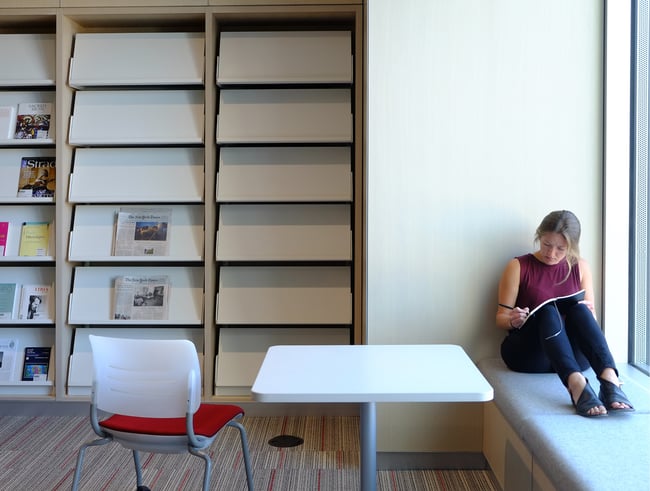Supporting Mental Health on College Campuses Through Design

Mental health issues are rising on university campuses. Over the last six years, the number of students reporting anxiety symptoms increased from 17% to 31%, according to a recent study by the Healthy Minds Network.
The pandemic only exacerbated the issue. Since 2020, universities have experienced a growing demand for mental health services—often outpacing available resources.
Mental health affects students’ motivation, engagement, and success, making it a top concern for administrators. According to the American Council on Education, nearly 70% of university presidents see student mental health as their most pressing issue.
Addressing the issue requires a holistic approach. In addition to increasing resources, universities need to make mental health services more accessible to students and create spaces that support wellness.
This article will discuss how campus planning and building design can help support students’ mental health.
Mental Health on College Campuses
Young adulthood can be a challenging time for mental health. According to Sarah K. Lipson, an assistant professor at the Boston University School of Public Health, 75% of the mental health problems experienced in one’s lifetime onset before the age of 24.
Many college students are tasked with navigating their health for the first time without parental support.
Over the last decade, reports of mental health problems among college students have steadily increased. The Healthy Minds Network study surveyed 96,000 US students across 133 campuses in the 2021-2022 academic year.
Of these students, 44% reported symptoms of depression, 37% said they experienced anxiety, and 15% said they have seriously considered suicide—the highest rates in the survey’s history.
Although mental health issues were rising before 2020, the pandemic’s impact cannot be overstated. The pandemic changed the way students engage, learn, and communicate. Traditional support networks—like student-run organizations and in-person classes—were no longer available, leaving students isolated.
The silver lining is that today’s college students are more likely to seek care than earlier generations. The stigma around mental health issues has decreased, and students are more willing to discuss the topic.
However, the students seeking care often outnumber the staff at counseling centers. Universities are facing an unprecedented challenge that requires creative solutions.
Supporting Mental Health Through Design
Supporting mental health on college campuses is both an administrative and design challenge. Along with health and wellness programming, students need spaces that better support well-being. The goal is to make mental health services accessible, improve social connections, and accommodate diverse needs.
Ingraining Wellness into Campus
Although today’s college students are more likely to seek mental health treatment, they may not know where to look. One strategy is to leverage public, high-traffic spaces and make mental health services easier to find.
Counseling services should move away from isolated areas of campus to a centralized, easily accessible location. Making these services more apparent reduces some of the barriers students face when seeking care.
Another strategy is to consolidate student services into a dedicated wellness center. Often, clinic services, psychological counseling, and fitness center amenities are in separate facilities.

Mental health services can combine with more traditional fitness amenities.
A wellness center creates an easily accessible, centralized location. Adding dining options and additional spaces for prayer and meditation serves students holistically—mind, body, and spirit. The goal is to create a space that meets multiple needs and provides preventative care resources.
Creating Social Opportunities
The pandemic highlighted the role social connection plays in maintaining mental well-being. College campuses have an opportunity to facilitate social connection and foster a sense of community through the built environment.
Flexible, open spaces allow for interaction, collaboration, and chance encounters with people of different backgrounds and cultures. Such spaces can exist in purpose-built student centers or more traditional academic buildings.

Flexible spaces help cultivate a campus community.
Universities might also consider ways of making existing public spaces more inviting for students. One of the most effective strategies is bringing the natural environment into interior spaces.
Organic materials, water features, and vegetation feed our innate preference to be in and among nature—a concept known as biophilia. Increasing daylighting and views can make a space more inviting, calming, and restorative.
In short, universities should look for ways to increase socialization and craft a student community. A vibrant, dynamic campus culture is perhaps the most powerful way to improve mental well-being.
Accommodating Diverse Needs
Supporting mental health also means providing spaces that cater to a diverse set of student needs. Across all market sectors, designers are becoming more intentional with acknowledging neurodiversity—the fact that everyone has different ways of thinking, learning, and expressing emotion.
Different brains require different spaces. Some students may prefer to study alone, while others need a group setting. Some may need a quiet space to focus, while others prefer background noise.

A variety of spaces and seating options accommodates different needs.
College campuses also have an opportunity to accommodate students of different backgrounds and life situations. Some students may face unique challenges that impact their mental health.
For example, food insecurity is growing among college students, especially students of color. The rising cost of living adds to the stress of college, impacts academic performance, and takes a toll on one’s mental health.
Locating food pantries and other services in a convenient location can help address disparities among students while combating the underlying issues that contribute to mental health decline.
An inclusive design process that engages a diverse range of students is the best way to determine their needs. Engaging students through surveys and workshops in the early stages of a project leads to the most successful outcomes. Learn more by reading our article on DEI in campus planning.
Learn More about Campus Design
Since the pandemic, higher education institutions are facing many challenges. With declining enrollment and shifting budgets, many university administrators are tasked with doing more with less.
These challenges come at a time when students need a greater amount of support. For many universities, addressing student mental health and promoting a culture of wellness is a top priority.
Wellness centers and public gathering spaces that accommodate a diverse set of student needs can be a part of the solution.
Often, such spaces do not require new buildings. With a large amount of existing building stock, universities have an opportunity to update aging facilities to fit today’s needs. This approach can also present cost savings and reduce a university’s environmental impact.
To learn more, read our article about aging facilities on college campuses.